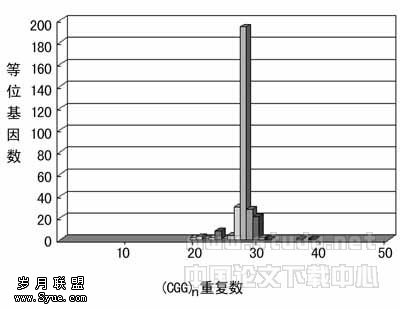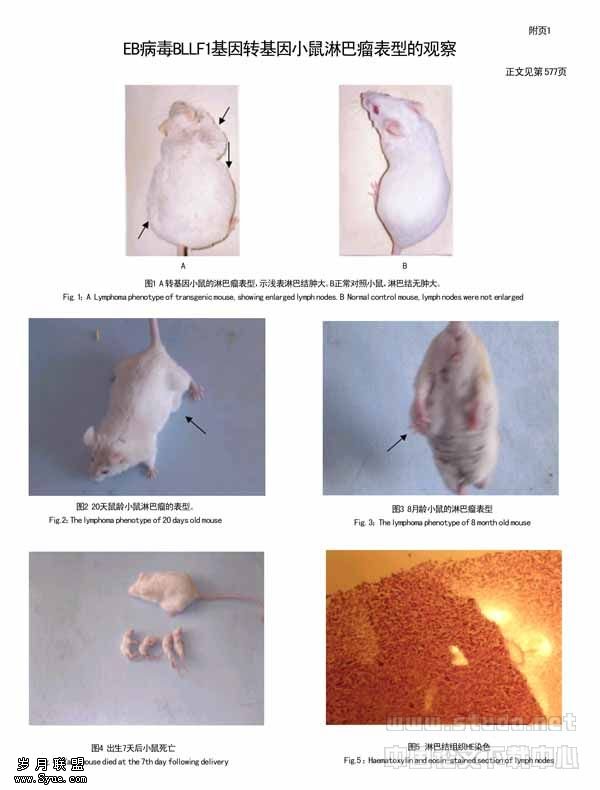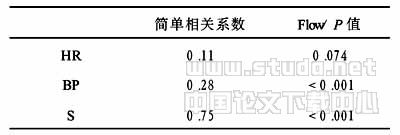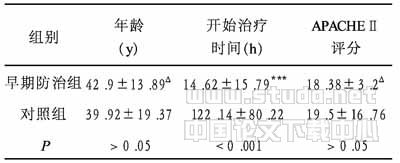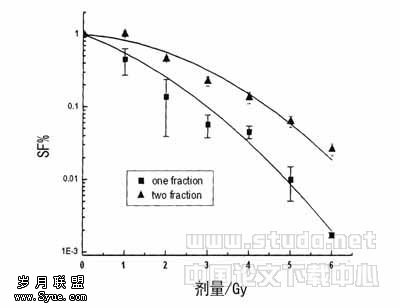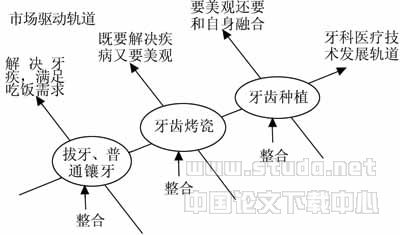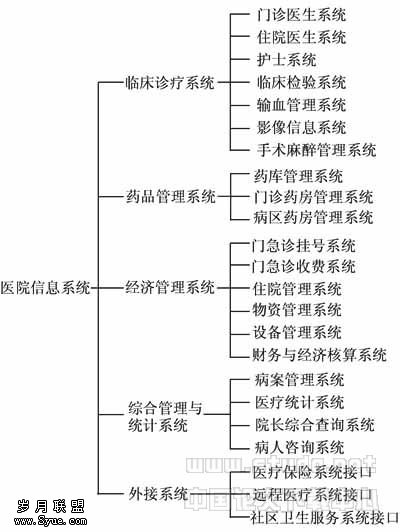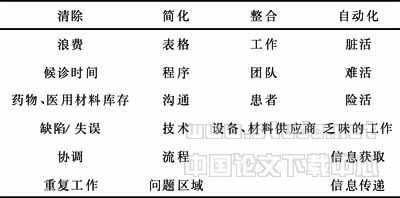Construction of prokaryotic expression vector of rhLEDGF p52
【摘要】 AIM: To construct the prokaryotic expression vector of rhLEDGFp52 gene,to obtain the rhLEDGF p52 protein. METHODS: rhLEDGFp52 gene was constructed into a prokaryotic expression vector pET30a(+) by recombinant DNA techniques and was identified by enzymatic digestion and sequence analysis. rhLEDGFp52 protein was induced expression by IPTG in E.coli BL21 (DE3), it was tested by Western blot and was purified by Ni-NTA His.Bind.Resin. RESULTS: We Successfully constructed the prokaryotic expression vector of rhLEDGFp52 gene and obtained its expression in E.coli BL21 (DE3),it was expressed in a soluble form and detected up to 34.63% of the total bacterial protein expressed in E.coli BL21 (DE3).Western blot analysis demonstrated that rhLEDGFp52 protein could spicifically integrate with LEDGF-ab.After purified by Ni-NTA His.Bind. Resin, the ultimate concentration of purified rhLEDGFp52 protein was 520μg/ml and its purity was 87.93%.· CONCLUSIONS: rhLEDGF p52 protein was obtained that provides an experimental basis for the further study of the biological function of rhLEDGFp52 protein.
【关键词】 rhLEDGFp52 gene expression E.coli protein purification
INTRODUCTION
Lens epithelium-derived growth factor (LEDGF) gene, located on human chromosome 9p21, generates two proteins by alternative splicing, viz., LEDGF/p75 and p52[1-3]. The recent research indicates LEDGF promoting growth and survival of many cell types and demonstrating potent ocular protective effect. Such as LEDGF significantly and positively effects the survival of retinal photoreceptor cells [4], lens epithelial cells, cos7 cells, skin fibroblasts, and keratinocytes [5]. It also modestly stimulates the growth of lens epithelial cells, retinal pigmented epithelial cells, corneal epithelial cells, cos7 cells, fibroblasts, and keratinocytes [5] . However,there is no studying on the ocular protective effect of LEDGFp52 at the present time yet. LEDGF/p75 (530 amino acid residues) and p52 (333 amino acid residues) are similar proteins; 325 of their N-terminal aa residues are identical, whereas the C-terminal 205 and 8 amino acid residues are different . By bioinformatics analysis, they are much likely to have analogical biologic function. Bioinformatics infers LEDGFp52 may be much more active. Therefore, its conceivable ocular protective effect and extent are worthy of investigating. The study is designed to clone, express and purify LEDGFp52 protein, to establish a basis for its further biologic function studying.
MATERIALS AND METHODS
Materials The plasmid of pLexA-rhLEDGFp52 was a benefit from professor Yu Long (deputy director of the National Human Genome Southward Research Center of P.R.C). EcoRI, SalI, HindIII,T4DNA Ligase and pUC18DNA were purchased from TaKaRa Biotechology Co.,Lid. pET30a(+) Expression System and Ni-NTA His.Bind.Resin were purchased from Novagen Co.,Lid. LEDGF-antibody was purchased from BD Biosciences Pharmingen. E.Z.N.A.Plasmid Mini Kit was purchased from Omega Co.,Lid. Agarse Gel DNA Fragment Purification Kit,IPTG,TMB and HRP labelled goat-anti-mice IgG were purchased from TIANWEI Biotechology Co.,Lid. E.coli DH5α and BL21(DE3) bacteria were provided by the Center Lab of Southwest Hospital of Third Military Medical University.
Methods
Obtain the target gene LEDGFp52 5μL pLexA-rhL- EDGFp52 plasmid DNA transfected E. coli Competent Cell DH5α, picked up 6 white clone from the transfected plate and extracted the plasmind DNA, then, used EcoRI and SalI digestting and identifying, at last, recovered LEDGFp52cDNA fragment from the agarse gel.
Construct the pUC18DNA-rhLEDGF p52 vector 8μL agarse gel recovered LEDGFp52DNA fragment was inserted into the EcoRI and SalI digested pUC18DNA by 1μL T4DNA Ligase. 10μL linked products transfected E.coli Competent Cell DH5α, picked up 6 single clone from the transfected plate and extracted the plasmind DNA, then, used EcoRI and HindIII digestting and identifying, at last,HindIII location was introduced.
Analyse the sequence of LEDGFp52cDNA 1μg digested and identified pUC18DNA-rhLEDGF p52 plasmind DNA was used in the double direction sequence analysing by M13 general primer,the whole process was accomplished by the Sequencing Department of Invitrogen Co.,Lid.
Construct the pET30a(+)-rhLEDGFp52 efficient prokaryotic expression vector The seqence analysed pUC 18DNA-rhLEDGFp52 was digested by EcoRI and HindIII, agarse gel recovered LEDGF p52cDNA fragment was inserted into EcoRI and HindIII digested efficient prokaryotic expression pET30a(+)vector. 10μL linked products transfected E.coli Competent Cell BL21(DE3), picked up 6 single clone from the transfected plate and extracted the plasmind DNA ,then, used EcoRI and HindIII for digestion and identification.
Induce expression and analyse solubility of the pET30a(+)-rhLEDGFp52 recombinated plasmid in E.coli Picked up single clone from the plate transfected by the digested and identified efficient prokaryotic expression pET30a(+)-rhLEDGFp52 plasmid, inoculated the single clone into 5mL LB culture media(containing 50mg/L kanamycin), overnightly cultured under the condition of 37℃250r/min. Then, according to the 1% proportion inoculated 5ml LB culture media and began culturing. While the A 600 reaching 0.58, added IPTG into culture media making the ultimate concentration to 0.1,0.5,1,2,4mmol/L. After IPTG induced expression 30minutes; 1, 2, 3, 4, 5, 6, 24hours, individually remained the bacteria culture media, 200μL were used in monitoring A 600 and 1mL were used in collecting bacteria precipitation, according to A 600 added 100μL bacteria lysis buffer, 4℃12 000g centrifuging for 20minutes and respectively collected serum and precipitation, at last, 15%SDS-PAGE electrophoresis was executed to analyse the rhLEDGF p52 expression in serum or precipitation.
Westernblot analysis Respectively collected serum and precipitation, 15%SDS-PAGE electrophoresis was executed.Transferred the protein to PVDF membrane after the electrophoresis completed,5% degrease milk powder blocked out,then,1:1 000 LEDGF-antibody was incubated for 30min under 37℃,washed the membrane 3times with 1×PBST,1:500 HRP labelled goat-anti-mice IgG was incubated for 1h under RT and washed the membrane 3times with 1×PBST,at last,used TMB in observing the color illustration.
Purify the recombinate protein with Ni-NTA-His.Bind.Resin Inoculated pET30a(+)-rhLEDGFp52 BL21(DE3) to the LB bacteria culture media, overnightly cultured under 37 ℃ surging , according to the 1% proportion expended the culture scale to 1 000mL,while the A 600 reaching 0.58,added IPTG into culture media making the ultimate concentration to 2mmol/ L and continuously cultured for 6h, collected bacteria and cleaved by ultrasound, centrifuged and gathered serum, then, affinity chromatograph applied with Ni-NTA-His.Bind.Resin, the specific process was refered to the manipulation manual of His-Tag fused protein purification provided by Novagen Corp. Sequently eluted the target protein by 10, 50, 100 and 150mmol/L imidazole elution buffer.At last,collected the elution samples and identified the purification efficiency by 15% SDS-PAGE electroporesis.Quantity One Software analysed the purity and concentration of the recombanated protein.
RESULTS
Obtain the target gene LEDGFp52 Two specific DNA bands were obvious after EcoRI and SalI digested pLexA-rhLEDGF p52 plasmid DNA ,the smaller size 1001bp was LEDGFp52 and the larger size 10.2kb was pLexA(Figure 1).
Figure 1 Results of target gene LEDGFp52 obtaining products of electrophoresis. Lane 1, 2, 3, 4 , 5, 6 were products after EcoRI and SalI digested; Lane 7 was pLexA-rhLEDGF p52 plasmid before EcoRI and SalI digested; Lane 8 was DNA markerVI(10 000, 7 500, 5 000, 2 500, 1 000, 250bp)
Construction and identification of the pUC18DNA-rhLEDGF p52 vector Agarse gel recovered LEDGFp52 DNA fragment was inserted into the EcoRI and SalI digested pUC18DNA, transfected E.coli Competent Cell DH5α, picked up 6 single clone from the transfected plate and extracted the plasmind DNA , then, used EcoRI and HindIII digestting and identifying , at last, 1001bp DNA bind was appeared , which was the target gene LEDGFp52(Figure 2).
Figure 2 Identification of recombinant pUC18DNA-rhLEDGF p52 with enzyme digestion. Lane 1 was pUC18DNA before EcoRIand SalI digested; Lane 2 was product of pUC18DNA after EcoRIand SalI digested; Lnae 3 was DNA markerVI(10 000,7 500,5 000,2 500, 1 000, 250bp); Lane 4 was pUC18DNA- rhLEDGF p52; Lane 5 was product of EcoRIand SalI digested pUC18DNA- rhLEDGF p52
Sequencing result of the recombinated plasmid The sequencing result of the recombinated plasmid indicated the sequence was homolog of the sequence encoding human LEDGFp52 in GeneBank. The specific seqence was cATG actcgcgatt tcaaacctgg agacctcatc ttcgccaaga tgaaaggtta tccccattgg ccagctcgag tagacgaagt tcctgatgga gctgtaaagc cacccacaaa caaactaccc attttctttt ttggaactca tgagactgct tttttaggac caaaggatat atttccttac tcagaaaata aggaaaagta tggcaaacca aataaaagaa aaggttttaa tgaaggttta tgggagatag ataacaatcc aaaagtgaaa ttttcaagtc aacaggcagc aactaaacaa tcaaatgcat catctgatgt tgaagttgaa gaaaaggaaa ctagtgtttc aaaggaagat accgaccatg aagaaaaagc cagcaatgag gatgtgacta aagcagttga cataactact ccaaaagctg ccagaagggg gagaaagaga aaggcagaaa aacaagtaga aactgaggag gcaggagtag tgacaacagc aacagcatct gttaatctaa aagtgagtcc taaaagagga cgacctgcag ctacagaagt caagattcca aaaccaagag gcagacccaa aatggtaaaa cagccctgtc cttcagagag tgacatcatt actgaagagg acaaaagtaa gaaaaagggg caagagggaa aacaacctaa aaagcagcct aagaaggatg aagagggcca gaaggaagaa gataagccaa gaaaagagcc ggataaaaaa gaggggaaga aagaagttga atcaaaaagg aaaaatttag ctaaaacagg ggttacttca acctccgatt ctgaagaaga aggagatgat caagaaggtg aaaagaagag aaaaggtggg aggaactttc agactgctca cagaaggaat atgctgaaag gccaacatga gaaagaagca gcagatcgaa aacgcaagca agaggaacaa atggaaactg agcaccaaac aacatgtaat ctacagTAAt.
Construction and identification of the pET30a(+)-rhLEDGFp52 efficient prokaryotic expression vector LEDGFp52cDNA fragment was inserted into EcoRI and HindIII digested efficient prokaryotic expression pET30a(+)vector. EcoRI and HindIII digested the recombinated plasmid, and electrophoresis demonstrated both the identified plasmids could release 1001bp DNA fragment(Figure 3) .
Figure 3 Identification of recombinant pET30a(+)-rhLEDGF p52 with enzyme digestion. Lnae 1 was DNA markerVI(10 000, 7 500, 5000, 2 500, 1 000, 250bp); Lane 2, 4 were pET30a(+)-rhLEDGF p52 before EcoRIand HindIII digested; Lane3, 5 were product of pET30a(+)-rhLEDGF p52 digested by EcoRIand HindIII
Induced expression and solubility analysis of the pET30a(+) -rhLEDGFp52 recombinate plasmid in E.coli The IPTG ultimate concentration to 2mmol/L could optimally induce fused protein expression in the pET30a(+)-rhLEDGFp52 transfected E.coli BL21(DE3), the protein was dissoluble and its apparent molecular weight was 35Kd,the content of protein was maximal after IPTG induced 6h and the soluble protein content was up to 35% of the total bacteria protein(Figure 4).
Figure 4 15% SDS-PAGE analysis of the inducing expression of recombinant proteins. Lane 1 was protein marker(94, 66, 45, 35, 24, 20, 14ku); Lane 2 was the expression of BL21DE3 before IPTG induced; Lane 3 was pET30a(+)-rhLEDGF p52BL21DE3 before IPTG induced; Lane 4, 5, 6, 7, 8, 9, 10 were pET30a(+)-rhLEDGF p52 BL21(DE3) expression after2mmol/L IPTG induced 30min; 1, 2, 3, 4, 5, 6h
Westernblot analysis The result indicated that protein which could integrate with LEDGF-antibody existing in the induced serum, its apparent molecular weight was 35kd which was in accordance with calculated molecular weight,however,there was no target band in the uninduced bacteria(Figure 5) .
Figure 5 Western blot analysis of the inducing expression of recombinant proteins.
Purification of recombinate protein LEDGF p52 The induced bacteria serum were purified with Ni-NTA His.Bind.Resin, 50mmol/L imidazole elution buffer had the optimal eluting effect. Collected eluting apexes and the ultimate concentration of the purified protein was 520mg/L by Bradford Examination.Quantity One Software analysis of 15% SDS-PAGE electrophoresis displayed the purity of purified LEDGF p52 was 87.93%(Figure 6)
Figure 6 15% SDS-PAGE analysis of purified result of recombinant proteins. Lane 1 was protein marker(94, 66, 45, 35, 24, 20, 14ku); Lane 2 was the first eluting apex after 50mmol/L imidazole elution buffer eluted; Lane 3, 4, 5, 6, 7, 8 were midway eluting apexes; Lane 9 was the last eluting apex after 50mmol/L imidazole elution buffer eluted; Lane 10 was the recombinated protein before Ni-NTA His.Bind. Resin purification
DISCUSSION
cDNA clone encoding ‘lens epithelium-derived growth factor’ (LEDGF) was firstly isolated from a human lens epithelial cell (LEC) library and expressed two forms of protein,they were known as p75 and p52[1,2,7 ]. The molecular mass of LEDGFp75 is 60 ku and LEDGFp52 is 35 ku, both LEDGFp75 and LEDGFp52 (Accession No. AF199339) were present in equal amounts in LECs[3]. Both LEDGFp75 and LEDGFp52 show interactions with the VP16 activation domain and several components of the general transcriptional machinery[2]. P52 is a potent co-activator with broad specificity, whereas LEDGFp75 is less active for most activation domains [1] . LEDGFp75 could integrate into the promoter of stress related genes and activate transcription, therefore, protect many types of ocular cells[8]. p52 is a co-activator of transcription and a co-factor for RNA splicing[1,2]. It has an important function on gene expression and regulation in mammalian cells. Thus, both the possible action of LEDGF p52 on ocular and its mechanism are worth researching.
In the construction process of rhLEDGFp52 gene prokaryotic expression vector,we inserted the target gene p52 into pUC18DNA and obtained the potential enzyme digesting location which we needed, meanwhile, it is easy to judge the inserted fragment by blue - white clone choices and convenient to analyse DNA sequence using M13 general primer.In the experiment, we insrted the correct target gene fragment into pET30 a(+) expression vector and transfected E.coli to express fused protein which contains 6×His.tag in C terminal.Expressing in fused protein form can enhance the stability of target protein and is propitious to protect target protein,at the same time,utilizing the conjuncture speciality of 6×His.tag and metal ions,we gained higher purity protein by commercial purification system.
While inducing expression of pET30a(+)-rhLEDGFp52 recombinated plasmid,we chose IPTG inducing and made the expression quantum of exogenous protein up to 34.63% of total bacteria protein. The ideal expression is profit from the optimizition of inducing temprature,the concentration of IPTG and temporal inducing. In the condition,it not only can guarantee the transcription activity of plasmid but also prevent overloading of the bacteria biosynesis. E.coli BL21(DE3) is a better host bactria for exogenous protein expression, it has lots of merits,such as rapid growth, easy zymolysis and expeditious production, therefore, it is a simple expression system of obtaining mass recombinated protein. We used LEDGF-antibody in Westernblot analysis of recombinated protein, the immunogen originates from 85-188 aa in the peptide chain of human LEDGF, which is on the beam of middle part of p52 peptide chain constituded by 333aa, it can fully integrate with fused protein and indicate the speciality of target protein.
In the purificiation process of recombinated protein with Ni-NTA His.Bind.Resin, we had modified the blueprint of operating manual.Owing to a much higher selectivity of imidazole, we eluted the target protein with imidazole concentration gradient elution buffer,it is propitious to obtain higher purity protein and regenerate Ni-NTA His.Bind.Resin. The purity of purified rhLEDGFp52 protein is 87.93% and its final concentration is 520μg/L, which provides an experimental basis for the further studying on the ocular protective function of rhLEDGFp52 protein.
【】
1 Ge H, Si Y, Roeder RG. Isolation of cDNAs encoding novel transcription coactivators p52 and p75 reveals an alternative regulatory mechanism of transcriptional activation.EMBO J ,1998;17:6723-6729
2 Ge H, Si Y, Wolffe AP. A novel transcriptional coactivator, p52, functionally interacts with the essential splicing factor ASF/SF2.Mol Cell ,1998;2:751-759
3 Singh DP, Kimura A, Chylack LT, Shinohara T. Lens epithelium-derived growth factor (LEDGF/p75) and p52 are derived from a single gene by alternative splicing. Gene ,2000;242:265-273
4 Nakamura M, Singh DP, Kubo E, Chylack LT, Shinohara T. LEDGF: survival of embryonic chick retinal photoreceptor cells.Invest Ophthalmol Vis Sci ,2000;41:1168-1175
5 Singh DP, Ohguro N, Kikuchi T, Sueno T, Reddy VN, Yuge K, Chylack LT, Shinohara T. Lens epitheliumderived growth factor: effects on growth and survival of lens epithelial cells, keratinocytes, and fibroblasts. Biochem Biophys Res Commun ,2000;267:373-381
6 Nishizawa Y, Usukura J, Singh DP, Chylack LT, Shinohara T. Spatial and temporal dynamics of two alternatively spliced regulatoryfactors, lens epithelium-derived growth factor(ledgf/p75) and p52, in the nucleus.Cell Tissue Res ,2001;305:107-114
7 Singh DP, Ohguro N, Kikuchi T, Chylack LT, Shinohara T. Gene sequence and functional studies of lens epithelial cell derived growth factor (LEDGF). Invest Ophthalmol Vis Sci ,1998;39:777
8 Singh DP, Fatma N, Usukura J, Chylack LT, Shinohara T. LEDGF: activation of transcription of many stress related genes.Invest Ophthalmol Vis Sci ,2000;(Suppl)41:1727


